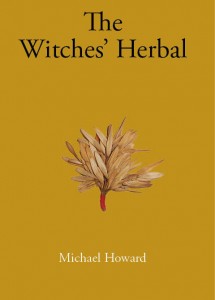The Witches’ Herbal
Michael Howard
Red Thread Books. 119 p. ISBN 978-0-9568114-2-4
www.redthreadbooks.co.uk
“The Witches’ Herbal is a guide to the subject of magical herbalism in three parts. It includes a concise history of herbal healing and the use of folk remedies from ancient times to the present day; a comprehensive A-Z herbal and plant glossary, providing the reader with a list of herbs and plants common to the British Isles with their botanical, cultural, magical, folkloric and medical siginficance; and in part three there is information on the magical, folkloric and pagan religious role of common British trees based on the Celtic Tree Alphabet.”
And to start with the latter: the Celtic Tree Alphabet comes from the The White Goddess by ’the poet and historical novelist’ Robert Graves. “In his book Graves formulated what he called the Celtic Tree Alphabet based on the 5th century CE Irish alphabet Ogham, allegedly invented by the god Ogma, and claimed by some as a relic of ancient druidism orally transmitted down the centuries by the bards.” Michael Howard uses the letters of the alphabet and the trees associated to these to give information on tree lore.
The first 22 pages of the book should be on the curriculum of every modern practitioner of ’the Craft of the Wise’. In the past herbal knowledge was the stock-in-trade for the cunning man, wise woman, witch, warlock and wizard. Anyone claiming to be a descendant of those practitioners, should know at least something of the use of herbs and plants. Be it for medical purposes, for magical purposes or for cosmetics. Howard describes the history of herbal knowledge as well as how that was viewed by the authorities. He names several well known books, such as Pliny’s Natural History, the Rosa Medicinae Anglica and the works of William Turner, John Gerard and Nicholas Culpeper. Several incantations or charms are given as well.
The A-Z Herbal and Plant Glossary is preceded by a warning, that some plants are highly toxic or may cause allergies. And that herbs are no substitute for orthodox medicines. “In all cases a doctor should be consulted.” The plants are listed under the common English name. Howard gives the botanical name, popular names, ‘flora’ (details on flowers and when they can be seen, and on the berries), habitat, magical significance and folklore and medicinal properties. Looking for my ‘key herb’, ‘klein hoefblad’ in Dutch (Tussilago farfara), I notice the lack of an appendix. The number of herbs in the book is not too large though, so I find it quickly under ‘Coltsfoot’. And I see that several trees are listed here as well, like Hawthorn and Lime, and the Horse Chestnut where this can be read: “Witches recommended carrying a chestnut to relieve rheumatic pain, however they were only effective if stolen or begged from another person.”

